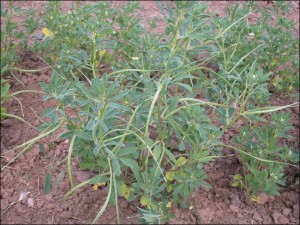HANKA
Year: 2006

Origin:
Fenugreek (Trigonella foenum-graecum L.) belongs to the very old genus Trigonella L. Fenugreek has spread as a cultivated crop across the Asian and the African continents. Later it was also introduced to Europe and America. The plant became agriculturally important as a forage crop and medical plant.
Description:
stem – erect or ascending and attains a height of O,4-O,6 m
leaf – short-petiolated, the leaflets are obovate to lanceolate, the stipules are large, ovate pointed and finely pubescent
flower – singly or in pair are born in leaf axils, calyx is tube-like, pale yellow corolla is twice the length of the calyx, wings are as long as the banner, the keel is rounded at the tip
fruit – elongated sabre-like pods are free from hairs, straight or distinctly curved, seeds are yellow to light brown, 10–20 of seeds per pod
Economical traits: